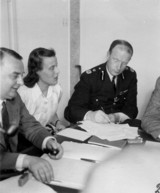County Chief Constable
Among the Police Archives at the Open University are the papers of Eric St Johnston who rose through the ranks to become the third Chief Inspector of Her Majesty’s Constabulary on 1st February 1967. Some may argue that St Johnston was the second Chief Inspector since the first appointment in 1962 was only a caretaker appointment.
Born in Birmingham in 1911, St Johnston studied Law at Cambridge (1929-32). He joined the Metropolitan Police as a civilian administrator but took advantage of the fast track promotion scheme introduced by Lord Trenchard (as Commissioner) to establish an officer corps for the Metropolitan Police. In May 1940 he was the officer in charge of Chelsea Police Station; two months later he became Chief Constable of Oxfordshire.
In 1943, the Civil Affairs Branch of the War Office was inaugurated to prepare for the re-establishment of the government of the civil populations of liberated Europe. The Home Office asked St Johnston to plan for the restoration of the police forces of those countries. Thus during the period March to December 1943, he was working part time at the War Office in addition to his duties as Chief Constable of Oxfordshire.
When General Eisenhower's staff was first formed in December 1943, St Johnston was again commissioned with the rank of Colonel, the only policeman commissioned at that rank, and placed in charge of the Public Safety Section of the G-5 Division of the Staff. In addition to preparing detailed plans for restarting the police and other services of the six countries to be liberated, the work involved selecting volunteers from the police forces, establishing a special training school and assignment of specific duties. The work also involved a detailed study of continental police organisations and methods. He was entrusted with the political negotiations for the initial military agreement between General Eisenhower and General de Gaulle. As Chief of the Public Safety Section of SHAEF, he was one of the first British officers to enter Paris after the war with de Gaulle's forces.
In September 1944, St Johnston was appointed Chief Constable of County Durham and, as soon as the plans for seizure of control of the German Police had been completed, he was released from the Army to take up the appointment on 1st January 1945. At the request of the US Government in 1948 and 1949 he conducted a survey of the work of the Public Safety agencies in the American Zone of Germany.
Documents
These are longer, written documents and, hence, may be rather more difficult for many students than those relating to the Blitz.
- A photograph of Eric St Johnston in 1947 during discussions in Munich about progress in de-Nazifying and reorganizing the German police.
- A letter from Eric St Johnston to his parents on his appointment to Oxfordshire.
- St Johnston’s third quarterly report as Chief Constable to the county Standing Joint Committee, 2nd April 1941. See the notes below.
- The Case of Mr James Florey, prepared by Superintendent D.E. Ponsford, Summer 1940. (It is important to read this bizarre ‘case’ bearing in mind the immediate military context, specifically the withdrawal of the British Expeditionary Force from France (Dunkirk), and the popular concern about landings by German paratroops.)
- Papers relating to Unity Mitford:
- 8th June 1941
- 6th January 1942
- 16th January 1942
- Papers relating to Sir Oswald Mosley (see the notes below):
- 26th November 1943
- 6th December 1943
- 14th December 1943
- 18th December 1943
- 26th December 1943
- 3rd January 1944
- Extracts from St Johnston’s diary of a visit to the American Zone of Germany in the summer of 1946. From 1943 St Johnston had been involved in planning the restructuring of Germany, and particularly the German Police, in the event of the Allies’ victory over the Nazis. On several occasions he visited Germany in the aftermath of the war to look at the progress of these policies.
Notes
The Standing Joint Committees were made up of magistrates and county councillors and they had a broad supervision of a Chief Constable and his force. By the time of the Second World War the Standing Joint Committees were losing authority to the Home Office. In boroughs the Chief Constables reported to Watch Committees. The latter were appointed by the local, elected borough council and they were usually made up of elected councillors. The Watch Committees had a greater degree of control over their Chief Constables than the Standing Joint Committees. But these were also losing authority to the Home Office. Back
Sir Oswald Mosley was married to Diana Mitford, the sister of Unity Mitford. As the leader of the British Union of Fascists, Sir Oswald was one of nearly 2,000 British citizens detained on the advice of M.I.5 and by Home Office orders under Defence Regulation 18b. Back
County Chief Constable
